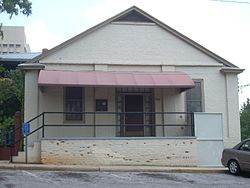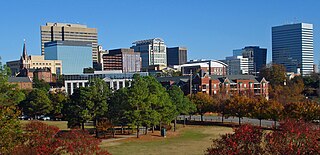
Columbia is the capital city of the U.S. state of South Carolina. With a population of 136,632 at the 2020 census, it is the second-most populous city in South Carolina. The city serves as the county seat of Richland County, and a portion of the city extends into neighboring Lexington County. It is the center of the Columbia, SC Metropolitan Statistical Area, which had a population of 829,470 in 2020 and is the 7th-most populous urban center in the Deep South and the 72nd-most populous metropolitan statistical area in the nation. The name Columbia is a poetic term used for the United States, derived from the name of Christopher Columbus, who explored for the Spanish Crown. Columbia is often abbreviated as Cola, leading to its nickname as "Soda City".

Five Points in Columbia, South Carolina is a shopping, restaurant, and nightlife area that attracts customers from the nearby University of South Carolina and the Columbia metropolitan area. It is the center for the city's annual St. Patrick’s Day Festival.
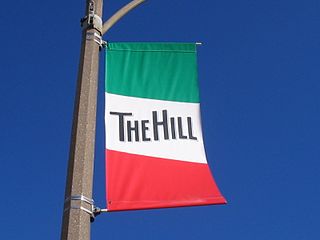
The Hill is a neighborhood within St. Louis, Missouri, located on high ground south of Forest Park. The official boundaries of the area are Manchester Avenue on the north, Columbia and Southwest Avenues on the south, South Kingshighway Boulevard on the east, and Hampton Avenue on the west.
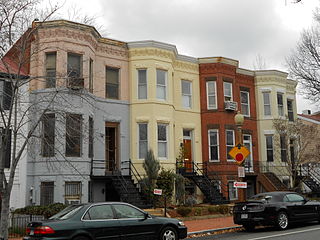
Capitol Hill is the largest historic residential neighborhood in Washington, D.C., stretching easterly in front of the United States Capitol along wide avenues. It is one of the oldest residential neighborhoods in Washington, D.C., and, with roughly 35,000 people in just under 2 square miles (5 km2), it is also one of the most densely populated. The name is also frequently used as a metonym for the United States Congress.
An arsenal is an establishment for the construction, repair, receipt, storage and/or issue of arms and ammunition.

Lawrenceville is one of the largest neighborhood areas in Pittsburgh in the U.S. state of Pennsylvania. It is located northeast of downtown, and like many of the city's riverfront neighborhoods, it has an industrial past. The city officially divides Lawrenceville into three neighborhoods, Upper Lawrenceville, Central Lawrenceville, and Lower Lawrenceville, but these distinctions have little practical effect. Accordingly, Lawrenceville is almost universally treated as a single large neighborhood.
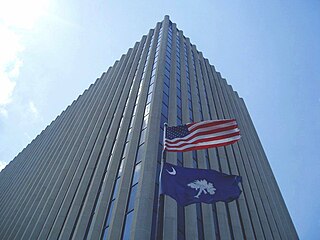
Jefferson Square, an office complex in downtown Columbia, South Carolina, is the headquarters of the state's Department of Health and Human Services which oversees the Medicaid program for South Carolinians. Located at 1801 Main St. in the city's historic Arsenal Hill neighborhood, the complex includes a 15-story, 150,000 sq ft (14,000 m2) office tower and a two-story courtyard plaza. Also on the Jefferson Square block are the offices of Wilson-Kibler real estate, two parking garages, a parking lot, and the Arsenal Hill Associate Reformed Presbyterian Church.
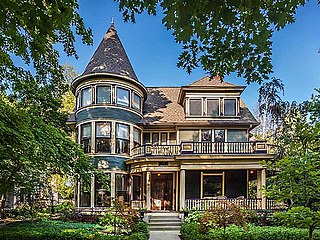
Woodruff Place is a neighborhood in Indianapolis located about a mile east of Downtown Indianapolis. It was established in the 1870s by developer James O. Woodruff as an early suburb of Indianapolis. Woodruff Place's boundaries are: 10th Street on the north, Woodruff Place West Drive on the west, Michigan Street on the south, and Woodruff Place East Drive on the east. This community was an independent municipality and maintained autonomy, even as the City of Indianapolis grew and expanded around the neighborhood, enclosing the community well within the city limits. Woodruff Place was incorporated in 1876 and remained an independent town until 1962 when it became one of the final municipalities to be annexed by the City of Indianapolis prior to the merger of city and county governments in 1969.

The South Carolina Governor's Mansion is a historic U.S. governor's mansion in the Arsenal Hill neighborhood of Columbia, South Carolina and the official residence of the governor of South Carolina. It is a Federal style home influenced by British Colonial plantations. The building has a white stucco exterior and originally served as faculty quarters for the Arsenal Academy, which together with the Citadel Academy in Charleston formed the South Carolina Military Academy. The Arsenal was burned along with the city of Columbia by Sherman's forces in February, 1865; the structure was the only surviving building and became South Carolina's executive mansion in 1868. On June 5, 1970, the building was registered with the U.S. National Register of Historic Places. The mansion is located on a single city block, and is surrounded by magnolia plants, elm and oak trees, and various other plants. It is accessed by a circular driveway around a fountain in front on the residence's main entrance. The building has a flat roof and a large central pavilion around the main entrance. The mansion has 15 rooms. It is located in Columbia Historic District I. The mansion is currently occupied by Governor Henry McMaster and his family.

Tower Grove South is a neighborhood of south St. Louis, Missouri. Formerly known as Oak Hill, Tower Grove South is bounded by Arsenal Street on the north, Chippewa Street on the south, Kingshighway Boulevard on the west, and Grand Boulevard on the east. The majority of the neighborhood was built following the extension of streetcar lines from downtown St. Louis. Commercial development in the neighborhood is concentrated on Grand Boulevard in the east and Morganford Road in the west of the neighborhood. There are also scatterings of commercial and mixed use buildings on interior intersections.

The University Neighborhood Historic District is roughly bounded by Gervais St., the Southern Railroad Cut, Greene St. and Pickens St. in the University Hill neighborhood of Columbia, South Carolina. The district is significant for its architecture, including Late Victorian, Late 19th And 20th Century Revival styles. It was added to the National Register of Historic Places in 2004.
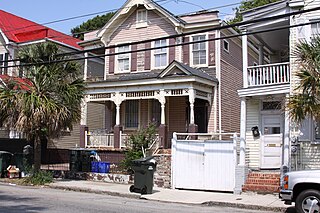
The U.S. state of South Carolina is located in the Southern United States. It is the 23rd largest state by population, with a population of 5,024,369 according to 2017 United States Census estimates.
Charles C. Wilson, whose full name is Charles Coker Wilson, was an American architect based in Columbia, South Carolina. Wilson was born in Hartsville, South Carolina, and graduated from South Carolina College with an engineering degree in 1886, continuing on to receive his master's degree in 1888. He briefly studied architecture in the Atelier Duray at the École des Beaux-Arts in Paris. Much of his work contained Beaux-Arts elements. Architects who worked for Wilson include Joseph F. Leitner, during 1901–1905, who became a noted architect in Wilmington, North Carolina; and Henry Ten Eyck Wendell, during 1905–1906.

The South Carolina State Arsenal in Charleston, South Carolina was built in 1829 in response to the alleged 1822 slave revolt led by Denmark Vesey. The alleged uprising never came to fruition and Vesey was publicly hanged in 1822. In 1842 the South Carolina Military Academy, a liberal arts military college, was established by the state legislature, and the school took over the arsenal the following year as one of 2 campuses, the other being the Arsenal Academy in Columbia, South Carolina. The school became known as the Citadel Academy because of the appearance of its building. From 1865 to 1881, during Reconstruction, Federal troops occupied the Citadel, and the school was closed. Classes resumed in 1882 and continued in this building until the school was relocated to a new campus on the banks of the Ashley River in 1922.
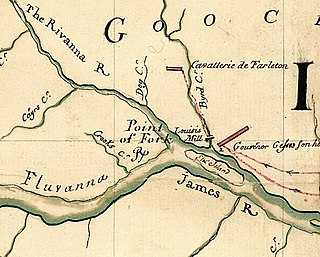
Point of Fork Arsenal was an arsenal established in the 18th century located near what is now Columbia, Virginia, United States. It was raided and destroyed on June 5, 1781, by Col. John Graves Simcoe of the Queen's Rangers. It was rebuilt and used for the manufacture and repair of arms and supplied material to combat the Whiskey Rebellion and to aid the Battle of Fallen Timbers. The arsenal remained in service until 1801, when it was abandoned in favor of a more centralized arsenal at Richmond, the Virginia Manufactory of Arms.

Florence C. Benson Elementary School, also known as Wheeler Hill School and the Benson Building, is a historic school building for African-American students located at Columbia, South Carolina. It was built in 1953–1955 in Wheeler Hill, a segregated African-American neighborhood, as an "equalization school." The one-story, three-finger plan school, is built of concrete block with a red brick veneer and reflects influences of the Modern and International styles. The school housed 18 classrooms. The school closed in 1975.

Lyles-Gudmundson House is a historic landmark home located in Columbia, South Carolina. It was built between 1918 and 1922, and is a two-story Classical Revival style brick dwelling. The home was a wedding gift for Evelyn Robertson Lyles, the daughter of Edwin Wales Robertson. A banker who is credited with much of Columbia's early twentieth century development, Robertson commissioned New York City architect James Brite to design his daughter's home as part of his Wales Garden neighborhood. Brite - a native North Carolinian who died in 1942 - was also the architect of The Braes in Glen Cove, New York and the famous Darlington Mansion near Mahwah, New Jersey.

Waverly Historic District is a national historic district located at Columbia, South Carolina. The district encompasses 132 contributing buildings in the first suburban development at Columbia. They were built between about 1898 and 1925, and the district includes examples of Queen Anne, Colonial Revival, Neoclassical, shotgun, American Foursquare, and Craftsman/Bungalow style architecture. The community has evolved from a predominantly white neighborhood into a community of African-American artisans, professionals and social reformers.

Columbia Historic District I is a national historic district located in the Arsenal Hill neighborhood at Columbia, South Carolina. The district encompasses nine contributing buildings and includes a complex of fine mansions and attractive homes built before the American Civil War. The buildings are in the Greek Revival, Italianate, Classical Revival, and the “Columbia Cottage” styles. They include the Governor's Mansion, Caldwell-Hampton-Boylston House, Lace House, and Palmetto Iron Works and Armory.

The Sand Hills Historic District in Augusta, Georgia is a historic district which was listed on the National Register of Historic Places in 1997. The district included 334 contributing buildings and a contributing site in a 231 acres (0.93 km2) area roughly bounded by Monte Sano and North View Aves., Mount Auburn St., Johns Rd., and the Augusta Country Club.
